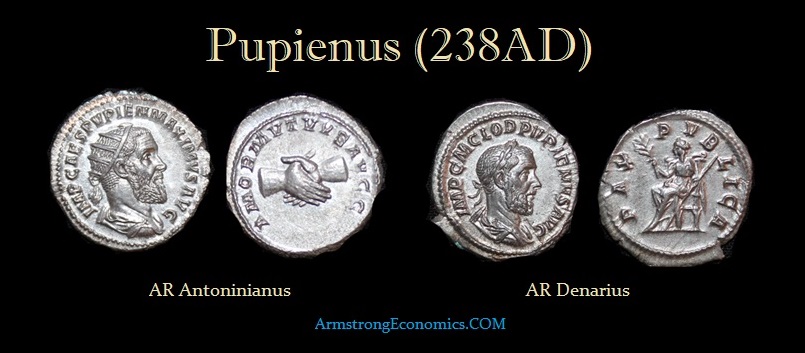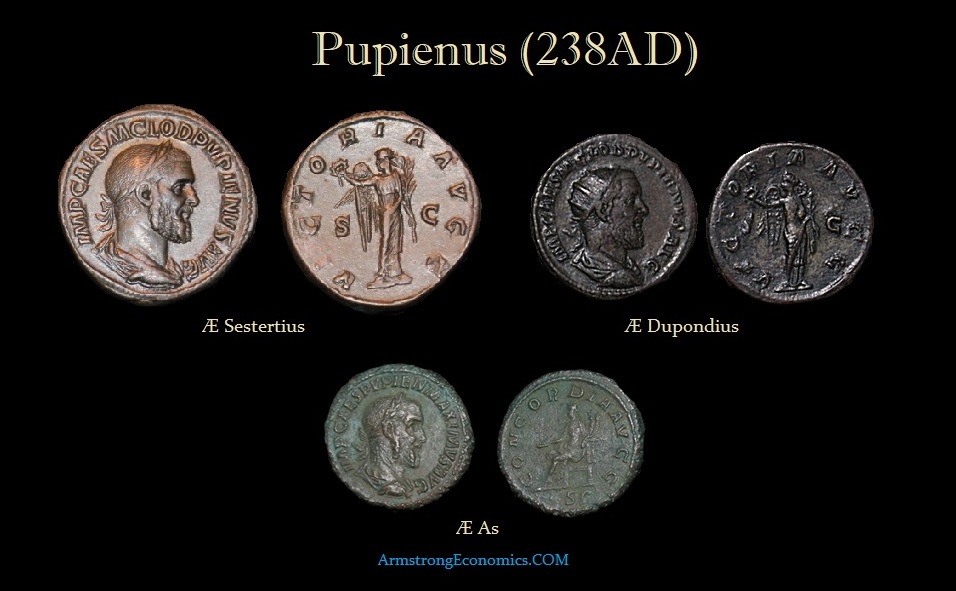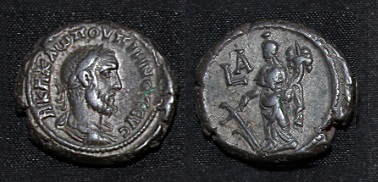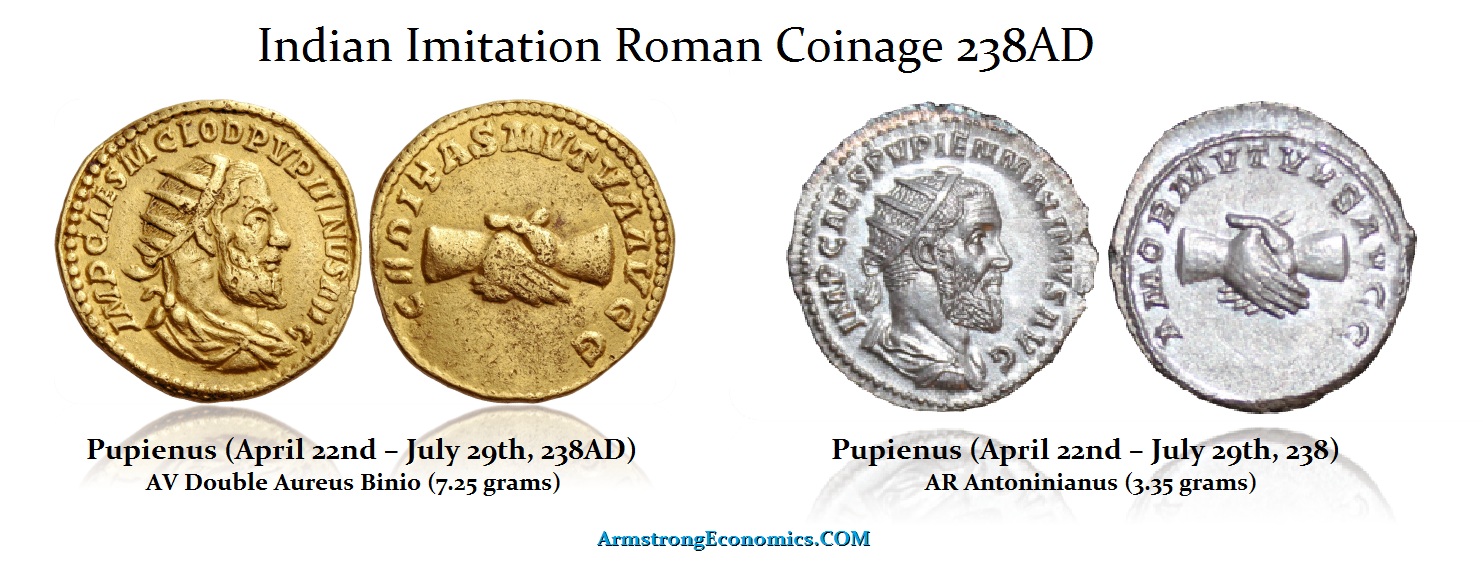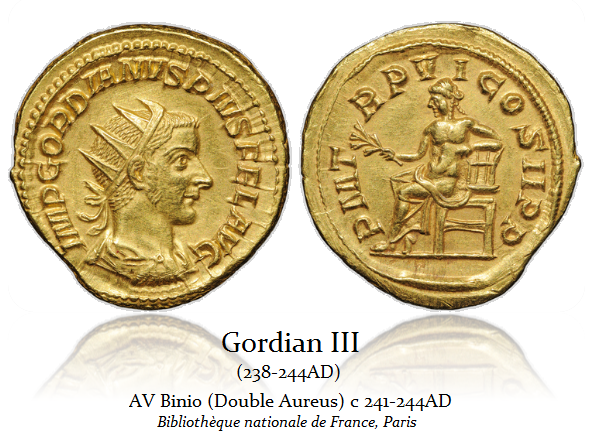PUPIENUS
238 AD
(April 22nd–July 29th, 238AD)
Marcus Clodius Pupienus Maximus was a senator of Rome at the time of the deaths of Gordian I and Gordian II in Carthage. The Senate, after having supported the Gordians and declared Maximinus I a public enemy, had little choice but to find someone to defend the Senate itself. It was finally decided to elect two of their own members, Balbinus and Pupienus, two ex-consuls, to be joint rulers of the empire. This was an arrangement reminiscent of the consuls of the old Republican era. They were certainly not young men but instead, both were in their late 60s or perhaps even mid-70s at the time. At the same time, the Senate created the Counsel of Twenty vigintiviri (of 26) to assist the two emperors in the task of opposing Maximinus.
Balbinus and Pupienus were two patricians and there was much resentment of the rich, noble class during this period of economic and political strife. A crowd had gathered at the Capitol and blocked the two new emperors from leaving hurling stones in their protest. They demanded that the new emperor should be selected from the Gordian family which was very popular among the people. The Senate had little choice and sent for the young 13-year-old Gordian III, grandson of Gordian I and nephew of Gordian II. Thus in a compromise move, Gordian III was given the rank of Caesar.
The new regime assumed immediate control of affairs in Rome itself during early February 238 AD. Maximinus by this time had reached the borders of Italy with his troops intent upon entering Rome. Pupienus, a man of considerable military experience, gathered what troops he could and set out to oppose Maximinus’ advanced army.
Upon entering Italy, Maximinus came to Aquileia on the coast of Northern Italy. The population closed its gates and refused him entry. Maximinus then began the siege of Aquileia. The Council of Twenty managed a blockade to cut off all supplies to Maximinus’ army. The tide was turned largely due to the fact that Maximinus’ Second Legion was from Latium, and these Italian soldiers did not take pleasure in laying siege to their homeland. A plot emerged between the Praetorian Guard and the Second Legion. Together, they stormed Maximinus’ tent and killed him on the spot along with his son – Maximus Caesar.

Pupienus returned to Rome to cheerful crowds with the heads of Maximinus and his son. But the lure of power already drove a wedge between the two elected joint Emperors. Balbinus was clearly jealous, feeling he had a more distinguished political career. At the same time, Pupienus believed his military career and victory gave him the honor of being the senior emperor. This clearly led to a division between the two Emperors, and in the end, both lost whatever support they had won among the praetorian guard. Finally, the praetorians stormed the palace, dragging the two Emperors naked through the streets of Rome. The joint Emperors were beaten and mutilated. Their hair was torn out, including their eyebrows. After this painful ordeal, they were finally taken to the praetorian camp and murdered on July 29th, 238 AD. The praetorians, who had always been loyal to the Gordians, then raised Gordian III to the rank of Augustus.
The reign of Balbinus and Pupienus was brief – 99 days in all. This saga illustrates the fate that so often fell upon even the most honorable men when power overruled reason.
Monetary System

Mints: Rome
Obverse legends:
IMP . C . M . CLOD . PVPIENVS AVG.
IMP. CAES . M . CLOD . PVPIENVS AVG.
IMP . CAES . PVPIEN . MAXIMVS AVG.
DENOMINATIONS
AU Aureus (6.54 grams)
AU Quinarius (4.61 grams)
AR Antoninianus
AR Denarius
AR Quinarius
COLONIAL
EGYPT
Æ Tetradrachm
Contemporary Imitation
This is an exceptionally rare Gold Bino of Pupienus (April 22nd–July 29th, 238AD) struck in India 238, AV 7.25 grams. The legend read IMP CAES M CLOD PVPIIINVS AVG Radiate, draped and cuirassed bust right. The reverse legend read: CARITAS MVTVA AVGG with Two hands clasped.
The question that this raises is that during this period, the issue of a Bino (Double Aureus) was standard. Here is a Bino of Gordian III who replaced Pupienus. Therefore, was this the typical Indian Imitation of a Bino issued by Pupienus that once existed and copied? In any event, this is a unique Bino of Pupienus and an extremely rare contemporary Indian imitation.
C 20. BMC –, cf. 81 note. RIC –, cf. 10b (Antoninanus). Calicó –, cf. 3178


